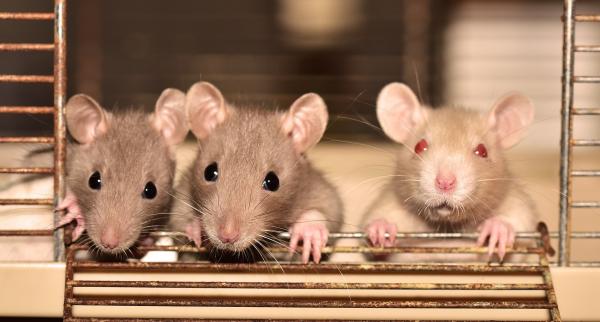I recently wrote about the need for change in the use of animal testing for biological research, including alternatives and barriers to acceptance. Here are some recent, new advances.
Alternatives
Many common antibiotics cause kidney damage in hospitalized patients, which is a significant problem for patients with chronic kidney disease, limiting their treatment options - the FDA has made the development of antibiotics for patients with chronic kidney disease a priority.
Progress has been limited because experiments, primarily in mice, do not model human kidney physiology well.
An exciting alternative development is the “bionic micro-kidney,” a microchip with electro-optical sensors recently developed at Hebrew University in Israel. The researchers embedded the microchip in human kidney tissue and measured glucose metabolism. In humans, glucose metabolism results, in part, in lipid accumulation, a component cause of kidney damage. In our rodent friends, renal lipids come from other lipids, not glucose. When the researchers used Empagliflozin, a diabetes treatment, to block renal glucose accumulation, the toxic effects of specific antibiotics on the kidney were also blocked. The microchip model mimics our renal metabolism better than rodents.
Strange Bedfellows
In 2007, the National Research Council of the National Academy of Sciences called for animal testing to be reduced and recommended using new technologies that could eventually eliminate the need for animal testing. Fifteen years later, the government is still far from reaching this goal.
Recently the issue has gained traction, with a collaboration between private industry, animal-rights groups, and developers of “alternate” technologies. Scientists from PETA, EPA, a global tobacco company, a law firm focused on chemical products, and an agriscience company recently wrote an editorial about the need for cross-sector partnerships to demonstrate the potential for New Approach Methodologies (NAMs) to revolutionize biological science.
NAMs refer to any new technology or approach that can provide information on chemical hazards and risk assessment without using animals. There are opportunities to evaluate different types of toxicity. For example, assessing tobacco and other nicotine-containing products, including electronic cigarettes, heated tobacco products, and certain smokeless products. All the stakeholders emphasize that regulatory acceptance is crucial for the advancement and acceptance of NAMs in society today.
For the private sector, it provides a way to evaluate toxicity more accurately, avoiding the ethical and reputational risk that comes with animal testing. For PETA, this is their core message, and for the scientific community, it provides a vehicle for their research to reach a broader, attentive audience.
This is an issue where industry has been ahead of the curve. The establishment, in 1981, of The Johns Hopkins Center for Alternatives to Animal Testing (CAAT) came from a three-year, $1 million grant from the Cosmetic, Toiletry and Fragrance Association. Cosmetic companies have led the way in reducing animal testing, some by as much as 90% for specific endpoints, and for some companies eliminating animal testing entirely.
The Role of Federal Agencies
National Toxicology Program – NTP’s Interagency Center for the Evaluation of Alternative Toxicological Methods focuses on developing and evaluating alternatives to animals for testing chemicals. Although they have no specific regulatory authority, the Interagency Center has evaluated data from alternative testing methods, providing information to researchers, regulators, and regulated industries.
FDA - Lawmakers and animal rights groups have been pressuring the FDA for years to stop requiring animal tests for new drugs and other products they regulate. The FDA is now seriously looking at ways to reduce and replace animal testing with tests that are more relevant to humans.
The FDA currently reviews animal data submitted by scientists to establish safe dosages for drugs, detect harmful toxins in foods, and accept new medical devices based on previously “certified” testing procedures. The FDA is currently examining ways to enhance and speed up the certification process so that more alternative tests are qualified, and their use is increased in the scientific community.
Currently, the FDA has approved alternative technologies for
- Developmental effects: tests that predict the potential for a drug to cause congenital disabilities or altered growth in fetuses or young children. Currently, the drug is given to pregnant rats, mice, or rabbits, and after the gestation period, the animals are killed, and the fetuses are examined for abnormalities. Alternatively, the test is done in human stem cells, measuring the ratio of two metabolites predictive of the likelihood of adverse developmental effects.
- Eye irritation: Currently, the Draize eye irritation test, commonly done in rabbits, consists of applying the drug to the cornea and scoring the degree of eye irritation. Alternatively, the use of an “ocular membrane,” a material developed to be similar to the cornea. The test measures the change in the optical density and damage to specific molecules after application of the drug, which are predictive of the degree of eye irritation.
- Skin irritation: Currently, again, the Draize tests applied to the skin, scoring the degree of skin irritation. Alternatively, stem cells are transformed to construct a 3-D model of human skin. The test measures the decreased viability of the cells after application of the drug, which is predictive of skin irritation.
EPA - currently requires animal testing for new chemicals and pesticides. They have recently prioritized, although not approved, the use of NAMs for chemical safety testing. Recently they have waived the requirement that all chemicals in pesticides must undergo animal testing for skin toxicity.
Driving change can get stymied at many turns. I am encouraged that the momentum to end animal testing will continue to grow. This effort shows how diverse and often seemingly opposed groups can come together, all seeking a similar goal, in this instance of moving beyond animal testing to more scientifically accurate and cost-effective alternatives.




